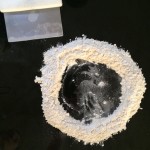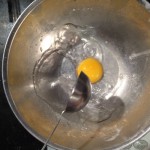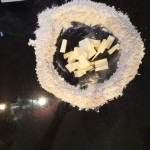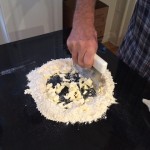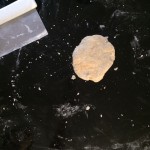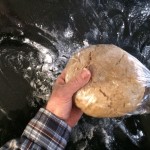A Lesson in Pastry Dough from Parker
As we prepared our recipe for Chicken Pot Pies this week, we decided to address one of the often-overlooked elements of this delicious mid-winter dish– the crust.
Knowing how to make a decent pie crust should be as essential as knowing how to tie your shoes. Some things you’ll notice in the following variations– it’s all about temperature and technique. Parker ran us through a couple of variations on his basic crust recipe using either lard or butter, machine or by hand, and they each and every one tasted absolutely delicious.
Pastry Dough with Butter
Ingredients:
– Butter– 95 grams or 1 cup, very cold
– Flour– 195 grams, or appx 2 1/4 cups total (1 cup Stutzman whole grain flour and 1.25 cups refined flour)
– Egg– 1 yolk
– Water– 3 tbsps
– Salt– just a pinch
Steps:
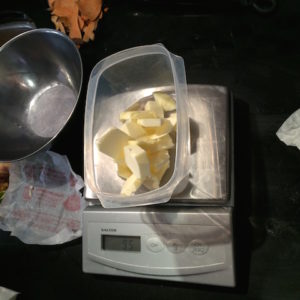 First stop– chilly butter.
First stop– chilly butter.
– You’ll need about 95 grams (appx 1 cup) cold-as-possible-without-being- frozen-butter. Cut it up into small pieces and then put it back into the fridge to chill from the cutting.
Next up– blending butter and flour.
-The goal here is for the flour to “host” the butter– incorporated but still distinct. When this dough hits the hot oven, the fat particles will grab hold of the flour and burst– this leaves you with a flaky, buttery crust.
-In a small bowl, whisk together your egg yolk, the 3 tbsps of water, and a pinch of salt.
Now, choose your own adventure in mixing:
– With the food processor:
Add in the flour, the salt and the very-cold-butter.
Pulse in the processor until it starts to resemble cornmeal.
Make a well, and pour in the yolk mixture, and continue a staccato pulse until it becomes a dough.
Wrap in cellophane and slide into the fridge.
– By hand
- In a bowl, mix together the flours and the salt, and turn it out onto a cold surface (like a pastry slab or countertop), and make a well in the center.
- In another bowl, whisk together the egg yolk and the water.
- Put the very-cold-butter in the middle.
- Pour in the yolk-water mixture. Begin to chop them both into the flour, compiling them into one heap.
- Use one hand and push the dough away from you at an angle, and chop-chop-chop all the way back. Don’t use too much force as you knead– you’ll make the dough tougher.
- Gently knead once the butter is incorporated
- …till you arrive at one uniform ball.
- Wrap it in cellophane and let it cool and rest in the fridge for a few hours.
Pastry Dough with Lard

Ingredients:
1 cup lard (at room temperature)
1/2 cup hot water (have a pot of water boiling on the stovetop)
4 cups — 3 Stutzman and 1 refined
Pinch of salt
Steps:
Combine the dry.
– First, combine flours in a bowl with your pinch of salt, and make a well. Set aside and work on the lard.
Melt the lard.
– Draw a half cup of water from your pot of boiling water and mix it into your lard, stirring gently to melt it. If the lard is in a metal bowl, place it on top of the boiling pot of water so it heats it up gently. Stir every once in a while, scraping down around the sides of the bowl.
Knead the dough.
– Let the lard water cool a bit, and then pour into the flour well and mix. Turn the mess out onto the table, and knead gently till it’s one dough ball.
Let it rest.
– Flatten into a disk, wrap in cellophane, and put it in the fridge to rest for at least a few hours.
A Note on Gluten
Gluten is what makes structure in breads. You work a yeast bread by kneading and rising to develop the gluten– making strands that hook onto one another to develop the “building” of the bread.
When you’re making a pastry dough, you don’t want to develop too much gluten. As you work the dough with the pastry cutter and the light kneading, it becomes elastic and a little tough. This is why the dough needs to rest and cool in the fridge before it’s rolled out to be baked. The longer you let it rest and cool, the more relaxed and easier to handle it will be.

